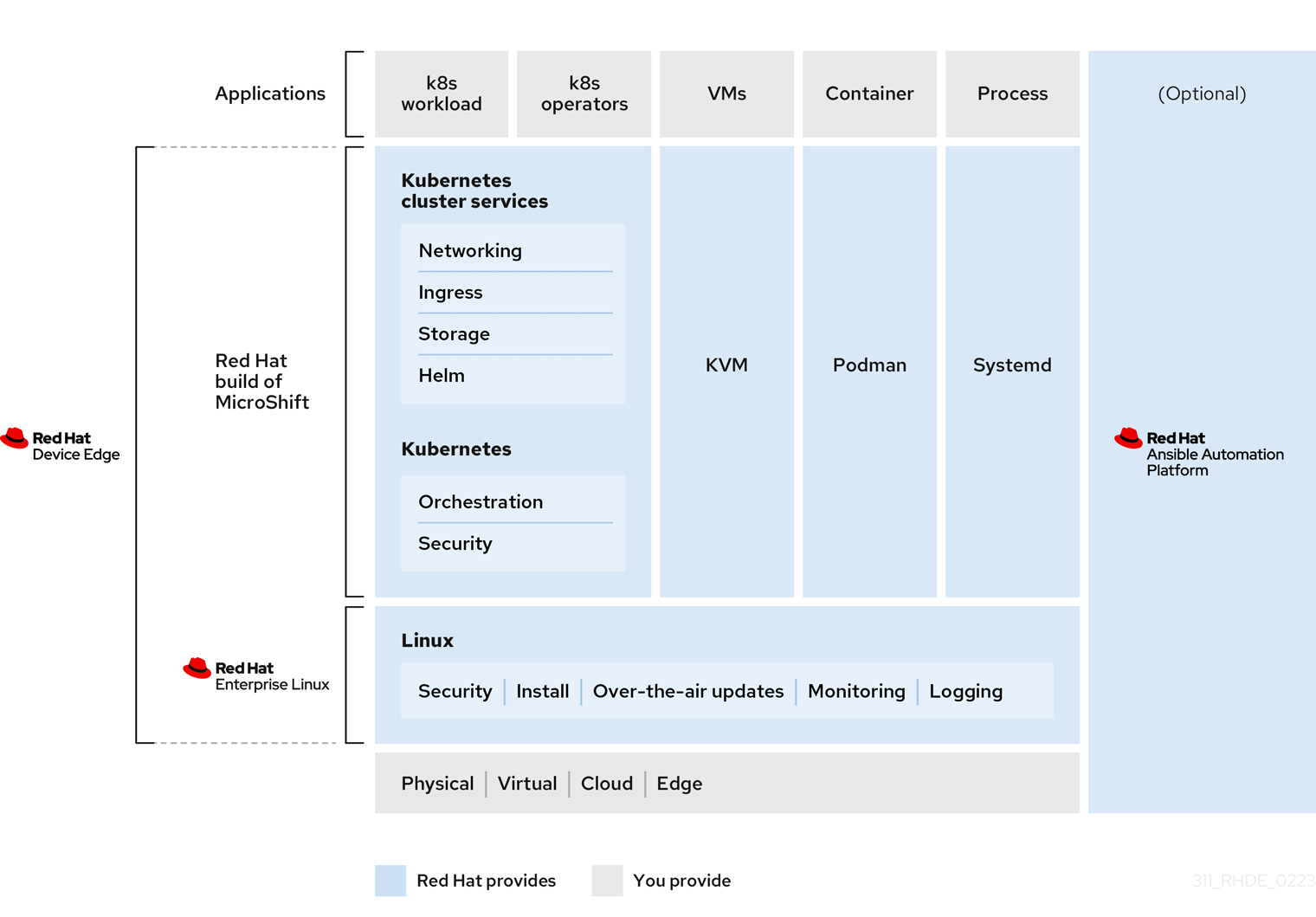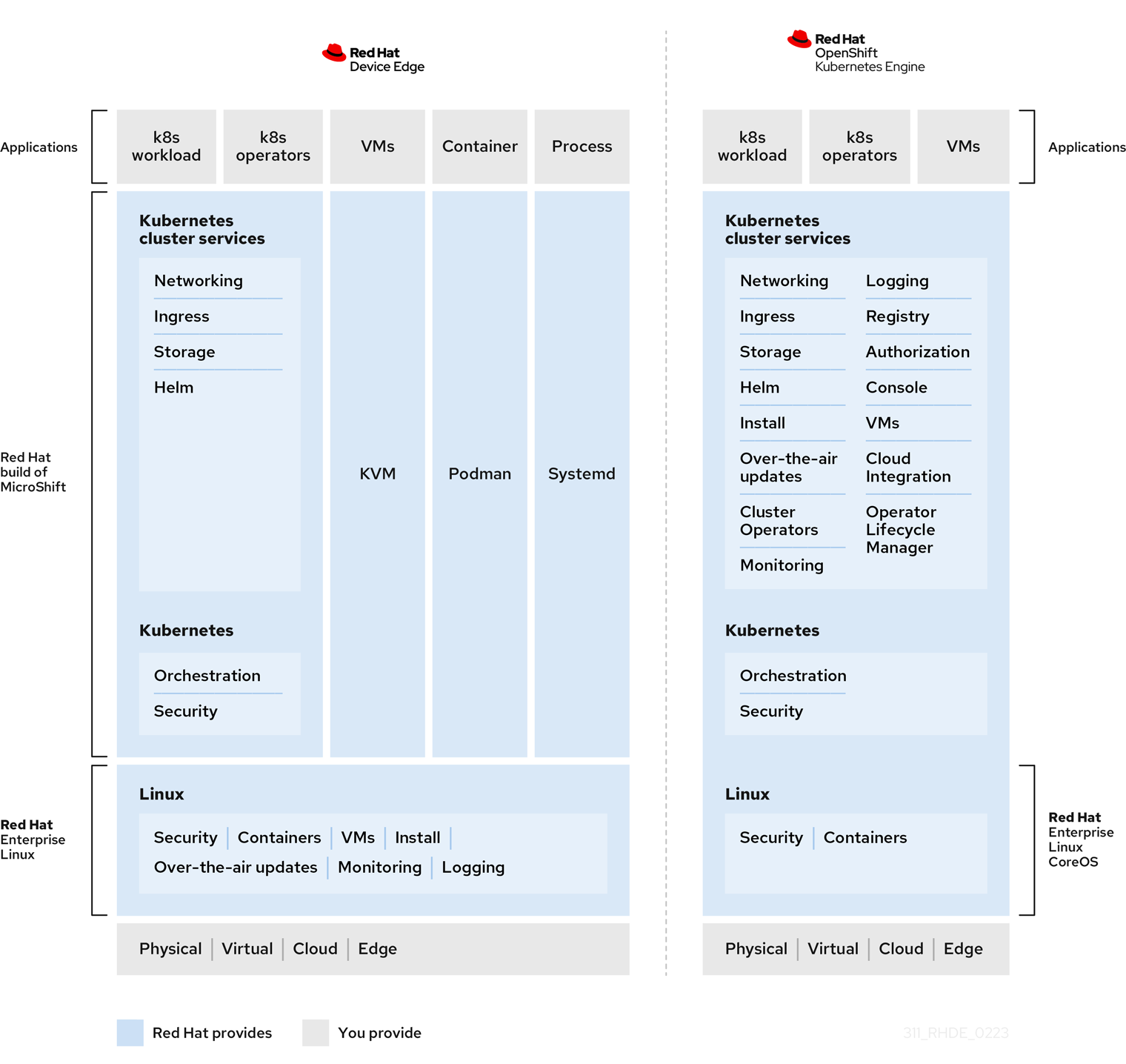Chapter 1. Red Hat Device Edge overview
Red Hat Device Edge delivers an enterprise-ready distribution of the Red Hat-led open source community project Red Hat build of MicroShift (MicroShift) with Red Hat Enterprise Linux (RHEL) and Red Hat Ansible Automation Platform.
1.1. About Red Hat Device Edge
Red Hat Device Edge is for organizations that need small-form-factor edge devices and support for bare metal, virtualized, or containerized applications. Red Hat Device Edge is a solution for large-scale computing at the device edge that combines MicroShift and an edge-optimized Red Hat Enterprise Linux (RHEL) operating system. MicroShift is a Kubernetes orchestration in a smaller, lighter-weight footprint. Together, these components of Red Hat Device Edge provide all of the benefits of containers deployed to the edge. You can manage Red Hat Device Edge by using Red Hat Ansible Automation Platform.
Figure 1.1. Red Hat Device Edge components
Figure 1.2. Red Hat Device Edge layers
For a non-technical description of Red Hat Device Edge, see Red Hat Device Edge.
1.1.1. Red Hat Device Edge product release notes
The latest release notes for each product that is part of Red Hat Device Edge are available at the following links:
- Red Hat build of MicroShift (MicroShift)
- Red Hat Enterprise Linux (RHEL) 9.2 release notes.
- Red Hat Enterprise Linux (RHEL) 9.4 release notes.
- Red Hat Enterprise Linux (RHEL) 9.6 release notes.
- Red Hat Ansible Automation Platform Release Notes
1.1.2. Red Hat Device Edge product release compatibility matrix
RHEL and MicroShift work together as a single solution for device-edge computing. You can update each component separately, but the product versions must be compatible. For example, an update of MicroShift from 4.18 to 4.20 requires a RHEL update. Supported configurations of Red Hat Device Edge use verified releases for each together as listed in the following table:
| RHEL Version(s) | MicroShift Version | Supported MicroShift Version → Version Updates |
|---|---|---|
| 9.6 | 4.20 | 4.20.0 → 4.20.z |
| 9.6 | 4.19 | 4.19.0 → 4.19.z; 4.19 → 4.20 |
| 9.4 | 4.18 | 4.18.0 → 4.18.z, 4.18 → 4.20 on RHEL 9.6 |
| 9.4 | 4.17 | 4.17.1 → 4.17.z, 4.17 → 4.18 |
| 9.4 | 4.16 | 4.16.0 → 4.16.z, 4.16 → 4.17, 4.16 → 4.18 |
| 9.2 | 4.15 | 4.15.0 → 4.15.z, 4.15 → 4.16 on RHEL 9.4 |
| 9.2 | 4.14 | 4.14.0 → 4.14.z, 4.14 → 4.15, 4.14 → 4.16 on RHEL 9.4 |
1.1.3. Red Hat Ansible Automation Platform compatibility
- When Red Hat Ansible Automation Platform is used to manage Red Hat Device Edge deployments, you can use any supported version listed here: Red Hat Ansible Automation Platform Life Cycle.
-
To manage an older version of Red Hat Enterprise Linux (RHEL) with Red Hat Ansible Automation Platform, see the
ansible-coresupport matrix page.
1.1.4. Red Hat Device Edge documentation
For more information about the Red Hat Device Edge products, see the following documentation:
1.1.5. Upgrade paths
For details about MicroShift upgrade paths, see the following documentation:

